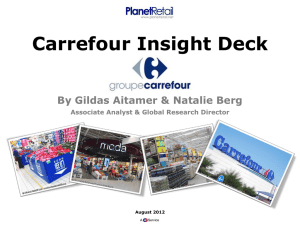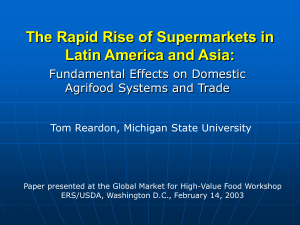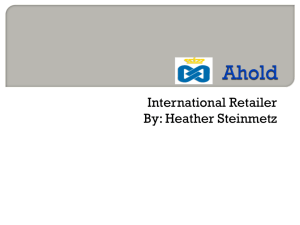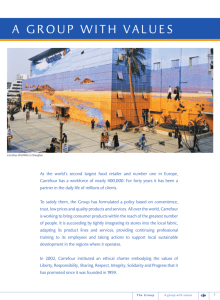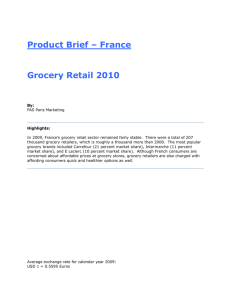Threats
advertisement
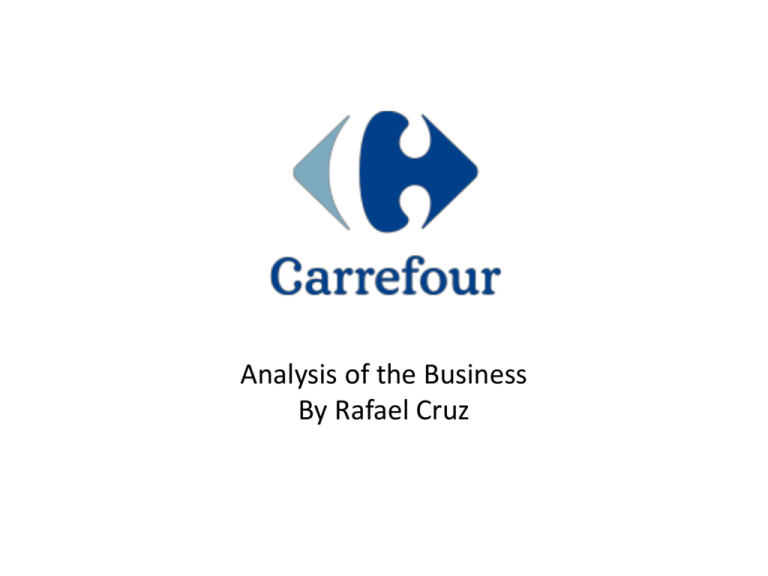
Analysis of the Business By Rafael Cruz Company Snapshot Carrefour S.A. is a French retail group that was founded in 1959. Carrefour competes against its rivals on the basis of price, convenience, and customer experience. Company Snapshot Carrefour is the second largest retailer in the world and its aim is “to become the preferred retailer” in all of its formats: Hypermarkets Grocery Stores Hard Discount Stores Convenience Stores Company Snapshot Carrefour operates 15,661 stores in 34 countries and had sales of €85.36 billion in 2009. Sales By Region Asia Latin 7% America 14% Europe (excluding France) 36% France 43% PEST Analysis Political Aspect Political unrest in The Middle East is causing oil prices to increase. This could cause product costs and distribution costs to rise which would result in decreased profits. Developing economies have placed restrictions on FDI to protect their domestic retail industries. These are both threats to Carrefour. PEST Analysis Economic Aspect The current devaluation of the Euro will make FDI and importing more expensive for European businesses. This is a threat to Carrefour. The rising Asian middle class accounts for approximately €3.06 trillion in annual consumer expenditures. This is a potential opportunity for Carrefour. PEST Analysis Social Aspect Consumers are more conscience of their health and the health of the environment. This is an opportunity for Carrefour because it has its own line of organic foods and it stocks fair trade products. Carrefour has also reduced its energy consumption and the amount of disposable plastic bags used by 12.8% and 53.8% respectively. PEST Analysis Social Aspect The Asian middle class is becoming more prosperous and as a result has shifted its diet to include more protein. This is a contributing factor to rising food prices. This poses a threat to Carrefour. PEST Analysis Technological Aspect Social networking sites provide an opportunity for businesses because they can be used to increase customer loyalty to their brand. Twitter can be used to inform customers of special deals at Carrefour stores. Facebook can be used to create a community for loyal Carrefour customers. PEST Analysis Summary Factor Trend Political Unrest in The Middle East . Threat FDI restrictions in developing economies. Threat Economic Evaluation The devaluation of the Euro. Threat The rising Asian middle class. Opportunity Impact Rank in (1=low; terms of 5=high) importance 3 3 4 4 1 5 Social Consumers more conscience Opportunity of health and environment. Change in Asian middle class Threat diet. 3 2 Technological The use of social networking Opportunity to increase loyalty 2 4 Industry Analysis Food Retail The global food retail industry had total revenues of $4.4 billion in 2009 and is expected to grow to $5.9 billion by the end of 2014. The major players in this industry, in order of annual revenue, are Walmart, Carrefour, Tesco, and Metro AG. Industry Analysis Power of Suppliers Carrefour purchases from a large group of suppliers. This forces the suppliers to compete against each other giving Carrefour the ability to negotiate the best price possible. The power of the suppliers is low. Industry Analysis Power of Buyers The preferences of the buyer dictate what Carrefour must place on its shelves. The switching costs for the buyer are very low. Carrefour has a frequent shopper program in an effort to increase the switching costs. Overall the buyer power is high. Industry Analysis Threat of Substitutes Restaurants and fast-food establishments pose a threat to Carrefour. The convenience of this option makes it appealing to consumers. The relative high cost prohibits most consumers from using this option as a permanent alternative. The threat of substitutes is moderate. Industry Analysis Threat of New Entrants The barriers to entry are relatively low for a small food retail shop. While these small shops are not able to compete directly with Carrefour, in large numbers they do have the ability to decrease Carrefour’s market share over time. The threat of new entrants is moderate. Industry Analysis Intensity of Rivalry Due to the low switching costs of the buyers and the similar product offerings between the industry rivals, competition is based mainly on price. With rising food costs, efforts to maintain low prices could put a strain on profit margins. The threat created by the intensity of rivalry is very high. Industry Analysis Summary Factor Evaluation Power of Suppliers The supplier power is low since Carrefour purchases from several different suppliers. Power of Buyers The buyer power is high due to low switching costs. Threat of Substitutes The threat of substitutes is moderate. Threat of New Entrants The threat of new entrants is moderate since small specialty shops can erode Carrefour's market share over time. Intensity of Rivalry Intensity of rivalry is very high because competition is based primarily on price and the consumer switching costs are low. Conclusions Thus Far Rising oil prices pose more of a long term threat. Carrefour can absorb any losses in the short term but it will eventually have to invest in further improvements to its distribution channel. The continued devaluation of the Euro could have a large impact on Carrefour’s decision to expand further into international markets. Conclusions Thus Far Carrefour’s rivals pose the biggest threat to its business. Since competition is based mainly on price, Carrefour should focus its efforts on strengthening its brand and building relationships with customers, thereby increasing the switching costs for the customer. Carrefour’s Key Competitors U.S. Retailer Targets lower and middle class consumers. British Retailer Targets middle and upper middle class consumers. German Retailer Targets business consumers as well as lower and middle class consumers. Strategic Business Groups In the Food Retail Industry there are five primary formats: Hypermarket Grocery Store • Large retail space with a mix of food and nonfood items • Large retail space selling primarily food items Hard Discounter • Small retail space selling food items at a deep discount Convenience Store • Very small retail space with a limited selection Cash & Carry • Retail space selling wholesale food items Generic Strategies of the Competition Broad Narrow Competitive Scope Competitive Advantage Low Cost Higher Cost Core Competencies of the Competition Every Day Low Prices An efficient distribution system allows them to be the low price leader. Customer Experience One way Tesco enhances customer experience is through the use of its Clubcard which allows customers to accumulate points that can be redeemed for store vouchers. Very Strong Cash & Carry Business Assumptions of the Competition Customers purchase based on price and therefore want the lowest price possible. Customers will overlook price if the experience is enjoyable. Product offering must be expanded to appeal to a broader market. Resources of the Competition An extremely efficient distribution channel as well as being the #1 retailer in the world. A loyal customer base and the #2 retailer in terms of profit. A strong wholesale arm that gives it the financial stability to expand into new markets. Financial Comparison of the Competition Walmart Carrefour Tesco Annual Revenue (€bn) Revenue Growth Net Income (€MM) Percent International Sales € 290 € 0.9% € 10,187 € 86 € -1.2% Metro AG 63 € 5.6% 494 € 2,336 € 66 -3.6% 383 24.7% 21.8% 31.1% 4.5% Global Market Rank (revenue) 1 2 4 3 Global Market Rank (profit) 1 3 2 4 Market Breakdown Food Retail Customer Location Urban Suburban Customer Type Rural Individual Business Customer Income Level Lower Middle Affluent Market Breakdown There is a food retail format to appeal to each type of customer. Hypermarket Grocery Store • Suburban • Lowermiddle class and up • Urban and Suburban • Lowermiddle class and up Hard Discounter • Urban • Consumers that do not have a lot of money to spend. Convenience Store • Urban and Suburban • Willing to pay more Cash & Carry • Appeals to the business to business market Brazilian Market The food retail market in Brazil is worth approximately €177 billion and is growing at a rate of 17.9%. Food retail accounts for the majority of Brazilian retail spending. There is a current shift towards non-food spending that is forcing grocery chains to carry more non-food items. Brazilian Market Income levels have been steadily increasing which has resulted in a “new middle class” (approximately 100 million people) which is driving retail spending. Brazil is considered to be an entry point to the South American market. Brazil will be home to the 2014 World Cup and the 2016 Olympic Games which will boost the country’s infrastructure. Russian Market The food retail market in Russia is worth approximately €222 billion and is growing at a rate of 20.5%. The growth rate of household income and disposable incomes has declined. The Russian Middle class is comprised of roughly 19 million individuals. Indian Market The food retail market in India is worth approximately €217 billion and is growing at a rate of 7.7%. Approximately 140 million Indians earn €13,000 per year making them middle class. The standard of living in India is improving and the Indian population is becoming accustomed to western culture. The Indian retail market is still not fully open to foreign competitors. Chinese Market The food retail market in China is worth approximately €255 billion and is growing at a rate of 6.8%. The per capita disposable income in urban areas has tripled in the last 10 years to approximately €2,300 which means that approximately 175 million Chinese are considered middle class. Living standards have increased leading the Chinese people to pursue a higher quality of life. The Chinese people spend approximately 41% of their income on food. BRIC Comparison Brazil Russia India China Size of Market (€bn) € 177 € 222 € 217 € 255 Market Growth Rate 17.9% 20.5% 7.7% 6.8% Growing Middle Class Yes Yes Yes Yes Market Open to Foreign Competitors Yes Yes No Yes Population Size (MM) 143 1,170 1,300 191 Social Media Social Media can be used by businesses to increase customer traffic by alerting customers of special deals in local stores. This use of Social Media has become very popular with the people of Brazil. Conclusions Thus Far Walmart has established itself in the marketplace as the low price leader and will be very difficult to compete against on price alone. Tesco has shown that a differentiated approach is successful in amassing a loyal following. The Cash & Carry arm of Metro AG is strong enough to support its efforts to expand into new markets. Conclusions Thus Far Each of the BRIC countries has experienced tremendous growth over the past several years and is forecast to continue to grow steadily. Brazil seems to be a very attractive market since it can be used as an entry point into the rest of South America. Regulations in India still prevent foreign competitors from entering the retail market but reforms are underway. Business Model Purchasing • Carrefour purchases in large quantities and at reduced prices from producers and wholesalers. Distribution • Carrefour has an efficient, cost saving, distribution channel to distribute the goods to its stores. Retail • Carrefour passes the savings on to the consumer in the form of lower prices. Performance While sales have been increasing, profits have been decreasing since 2007. In the past, Carrefour has been known to maintain prices even though costs are increasing. Net Sales (Billions) Profit (Billions) 90 2.5 85 2 80 1.5 Net Sales Profit 75 1 70 0.5 65 0 2004 2005 2006 2007 2008 2009 2004 2005 2006 2007 2008 2009 Distribution of Sales By Format Revenue contributions from hypermarkets and grocery stores has increased. These two store formats comprise the majority of Carrefour’s retail stores. Hypermarket Grocery Store 63.0% 25.0% 62.0% 20.0% 61.0% 60.0% 15.0% 59.0% 58.0% 10.0% 57.0% 56.0% 5.0% 55.0% 54.0% 0.0% 2004 2005 2006 2007 2008 2009 2004 2005 2006 2007 2008 2009 Distribution of Sales By Format The hard discounter segment has seen a 3% increase over the past several years. There has been an 11% decrease in the contribution of convenience and cash & carry formats. Hard Discounter Other 12.0% 18.0% 16.0% 10.0% 14.0% 8.0% 12.0% 10.0% 6.0% 8.0% 4.0% 6.0% 4.0% 2.0% 2.0% 0.0% 0.0% 2004 2005 2006 2007 2008 2009 2004 2005 2006 2007 2008 2009 Distribution of Sales By Region Sales in the European market have been in decline. The current depressed state of the economy is a contributing factor. 69% of Carrefour’s annual sales are generated in Europe. France Europe (excluding France) 52.0% 39.0% 38.5% 38.0% 37.5% 37.0% 36.5% 36.0% 35.5% 35.0% 34.5% 34.0% 50.0% 48.0% 46.0% 44.0% 42.0% 40.0% 38.0% 2004 2005 2006 2007 2008 2009 2004 2005 2006 2007 2008 2009 Distribution of Sales By Region Sales in the South American and Asian markets have been increasing. Growth in these regions is an opportunity for Carrefour to increase its market share and decrease its reliance on the European market. South America Asia 16.0% 8.0% 14.0% 7.0% 12.0% 6.0% 10.0% 5.0% 8.0% 4.0% 6.0% 3.0% 4.0% 2.0% 2.0% 1.0% 0.0% 0.0% 2004 2005 2006 2007 2008 2009 2004 2005 2006 2007 2008 2009 Key Assets Assets 2008 2009 %Δ Goodwill €11.3B €11.5B 2% Fixed Assets €14.8B €15B 1% Investment Properties Receivables €346MM €455MM 32% €2.9B €2.2B 24% Cash & Cash Equivalents €5.3B €3.3B 60% BCG Matrix Stars Question Marks Cash Cows Dogs Market Growth Rate High Low High Relative Market Share Low Value Chain Analysis Primary Activities: The two most important are Marketing and Sales as well as Service. Carrefour is a one-stop-shop for all of the consumer’s shopping needs but Carrefour is not perceived to have the lowest price. Providing an excellent customer experience is how Carrefour maintains market share. Secondary Activity: The most important is procurement. Maintaining a relationship with many different suppliers and negotiating for the lowest price. SWOT Strengths Extensive network of suppliers Brand is ranked in the top five of most valuable retail brands Very successful private label brands Opportunities The growing Asian market The growing South American market Weaknesses Not keeping up with competitors' investment in Brazil. Losing market share in European market Threats The depressed European market accounts for 69% of revenues. Consumer preferences are changing toward smaller local stores. Generic Strategy Broad Narrow Competitive Scope Competitive Advantage Low Cost Higher Cost Grand Strategy Carrefour aims to be “the preferred retailer” in all of its formats. Carrefour will divest from a market when it is not among the top retailers. Examples include Mexico, Russia, Japan, and South Korea. Carrefour has been successful in entering new markets by forming a joint venture with an existing operator. This allows Carrefour to gain information on the shopping habits of the local consumer to ensure a successful store. Recent Strategic Moves Carrefour has been in talks to sell its Dia % brand as well as its real estate arm. This will give Carrefour cash that it can invest in new markets. Carrefour is introducing Planet Carrefour which is a very large hypermarket that offers customers services such as cooking classes and snacking areas. Carrefour is trying to gain lost market share by improving the customer experience. Conclusions Selling the Dia % brand will narrow Carrefour’s target customer base which will allow it to better serve its current customers. Expanding further into the Asian and South American markets will decrease Carrefour’s reliance on the European market. Conclusions Carrefour has strong brand recognition in Brazil which gives it an advantage over its competition. By investing in its stores, Carrefour can regain lost market share. Asia shows promise for Carrefour. Carrefour has already had success and failure in Asia. Carrefour can use what has worked in past Asian ventures to expand its current operations.
